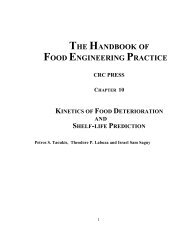A combined discreteâcontinuous model describing the lag phase of ...
A combined discreteâcontinuous model describing the lag phase of ...
A combined discreteâcontinuous model describing the lag phase of ...
Create successful ePaper yourself
Turn your PDF publications into a flip-book with our unique Google optimized e-Paper software.
172 R.C. McKellar, K. Knight / International Journal <strong>of</strong> Food Microbiology 54 (2000) 171 –180<br />
function; however, <strong>the</strong>re are some limitations to <strong>the</strong> Some <strong>of</strong> <strong>the</strong> fundamentals <strong>of</strong> this approach have<br />
use <strong>of</strong> this type <strong>of</strong> function. For example, it can be been discussed by McMeekin et al. (1993). These<br />
shown ma<strong>the</strong>matically that <strong>the</strong> Gompertz rate is authors and o<strong>the</strong>rs emphasized <strong>the</strong> limits <strong>of</strong> this<br />
always <strong>the</strong> maximum rate and occurs at an arbitrary method, <strong>the</strong> most severe <strong>of</strong> which is <strong>the</strong> fact that OD<br />
point <strong>of</strong> inflection (Garthright, 1991, 1997). The methods are comparative only, and cannot be used to<br />
Gompertz equation tends to overestimate m as it fits predict viable counts unless some attempt at calia<br />
sigmoidal curve to a straight line. In addition, <strong>the</strong> l bration is made (McMeekin et al., 1993; Baranyi and<br />
calculated with <strong>the</strong> Gompertz is always at a defined Roberts, 1995). McClure et al. (1993) used a simple<br />
point relative to <strong>the</strong> upper and lower asymptotes quadratic equation to relate OD to viable counts.<br />
(Garthright, 1991, 1997). Thus, empirical equations Dalgaard et al. (1994) used two equivalent methods<br />
have a limited ability to enhance our knowledge for calibration: one in which stationary <strong>phase</strong> cells<br />
concerning <strong>the</strong> physiological stages <strong>of</strong> bacterial were diluted to <strong>the</strong> appropriate OD, and <strong>the</strong> o<strong>the</strong>r in<br />
adaptation to new environment and subsequent which samples for OD and viable count were taken<br />
growth. during growth. Predicted generation times were<br />
It has been suggested that connecting <strong>the</strong> behavior lower with viable count data (Dalgaard et al., 1994),<br />
<strong>of</strong> a single cell to that <strong>of</strong> <strong>the</strong> whole population is <strong>the</strong> and this factor has been taken into account in later<br />
next stage in developing a more mechanistic ap- studies (Miles et al., 1997). Similar methods have<br />
proach to predictive food microbiology (Baranyi, been used to relate turbidimetric and viable count<br />
1997). While <strong>the</strong>re have been some attempts to data (Chorin et al., 1997).<br />
develop mechanistic <strong>model</strong>s for bacterial growth In some studies, <strong>the</strong> Gompertz equation was fitted<br />
(Baranyi and Roberts, 1994, 1995; Hills and Wright, directly to OD data; however, no data was available<br />
1994; Hills and Mackey, 1995), <strong>the</strong>se <strong>model</strong>s tend to<br />
7<br />
at below <strong>the</strong> minimum detectable OD (ca. 10 cfu/<br />
view bacteria as a homogeneous population, and ml) thus <strong>the</strong> estimates for l and m should be<br />
<strong>the</strong>re have been few attempts to <strong>model</strong> bacterial questioned (Hudson, 1994; Hudson and Mott, 1994).<br />
adaptation and growth on <strong>the</strong> basis <strong>of</strong> single cells. A form <strong>of</strong> calibration was achieved by relating l<br />
Recently, a <strong>model</strong> was proposed in which <strong>the</strong> using OD measurements to that determined with<br />
bacterial population was divided into non-growing viable counts by a regression equation (Hudson and<br />
and growing cells (McKellar, 1997). This <strong>model</strong> was Mott, 1994). McMeekin et al. (1993) have discussed<br />
expressed in <strong>the</strong> form <strong>of</strong> differential equations, and <strong>the</strong> correct way to fit <strong>the</strong> Gompertz function to %<br />
<strong>the</strong> behavior <strong>of</strong> <strong>the</strong> two types <strong>of</strong> cells was <strong>model</strong>ed transmittance data, and this method has been used to<br />
independently. Buchanan et al. (1997) have proposed calculate generation times (Neumeyer et al., 1997).<br />
a <strong>model</strong> which takes into account <strong>the</strong> variation in O<strong>the</strong>r studies have been carried out without any<br />
adaptation (or <strong>lag</strong>) time <strong>of</strong> individual cells. Simula- apparent calibration (Huchet et al., 1995). l values<br />
tions with this <strong>model</strong> gave rise to ‘‘traditional’’ have been estimated from OD data by extrapolation<br />
growth curves; however, <strong>the</strong>se authors did not pro- <strong>of</strong> <strong>the</strong> exponential portion <strong>of</strong> <strong>the</strong> curve back to <strong>the</strong><br />
vide experimental evidence for <strong>the</strong>ir <strong>model</strong>. More initial cell numbers (Breand et al., 1997); however,<br />
recently, Baranyi and Pin (1999) and Baranyi (1998) this method may be inaccurate since <strong>the</strong> growth rate<br />
have proposed a <strong>lag</strong> <strong>model</strong> based on behavior <strong>of</strong> estimated from <strong>the</strong> OD data may be lower than that<br />
individual cells.<br />
obtained during <strong>the</strong> period <strong>of</strong> maximum growth<br />
Construction <strong>of</strong> <strong>model</strong>s using viable count data is (McMeekin et al., 1993).<br />
time consuming and expensive, and researchers have Interestingly, <strong>the</strong> time to detection (t<br />
d) approach<br />
explored o<strong>the</strong>r, more rapid, methods for accumulat- has not been used to any great extent. The td<br />
for a<br />
ing sufficient data for <strong>model</strong>ing. One <strong>of</strong> <strong>the</strong> simplest turbidimetric instrument can be defined as <strong>the</strong> time<br />
method is <strong>the</strong> use <strong>of</strong> optical density (OD), where required for an initial measurable increase in OD.<br />
growth can be related to <strong>the</strong> increase in turbidity <strong>of</strong> a The difference between td<br />
for serial two-fold dilu-<br />
bacterial culture. This method lends itself particu- tions gives <strong>the</strong> doubling time, from which <strong>the</strong> m can<br />
larly well to automation, and a number <strong>of</strong> studies be determined (Cuppers and Smelt, 1993). The l can<br />
have used automated turbidmetric instruments such be calculated subsequently by <strong>the</strong> difference between<br />
as <strong>the</strong> Bioscreen (McClure et al., 1993; Huchet et al., <strong>the</strong> predicted td<br />
based on <strong>the</strong> m, and <strong>the</strong> observed td<br />
1995). (Cuppers and Smelt, 1993). This method was used to














